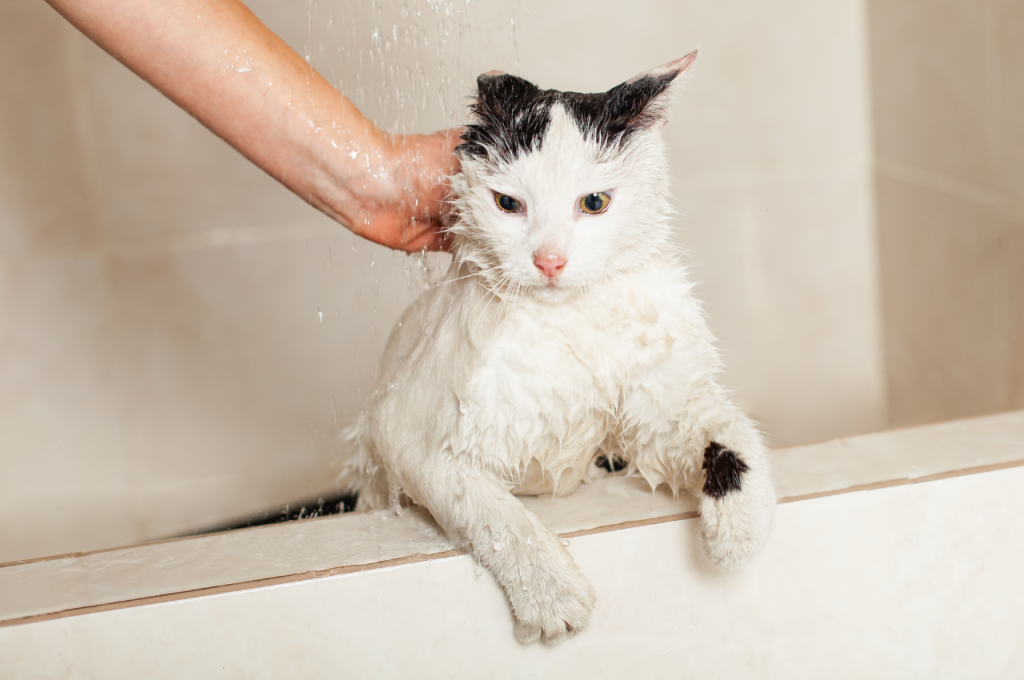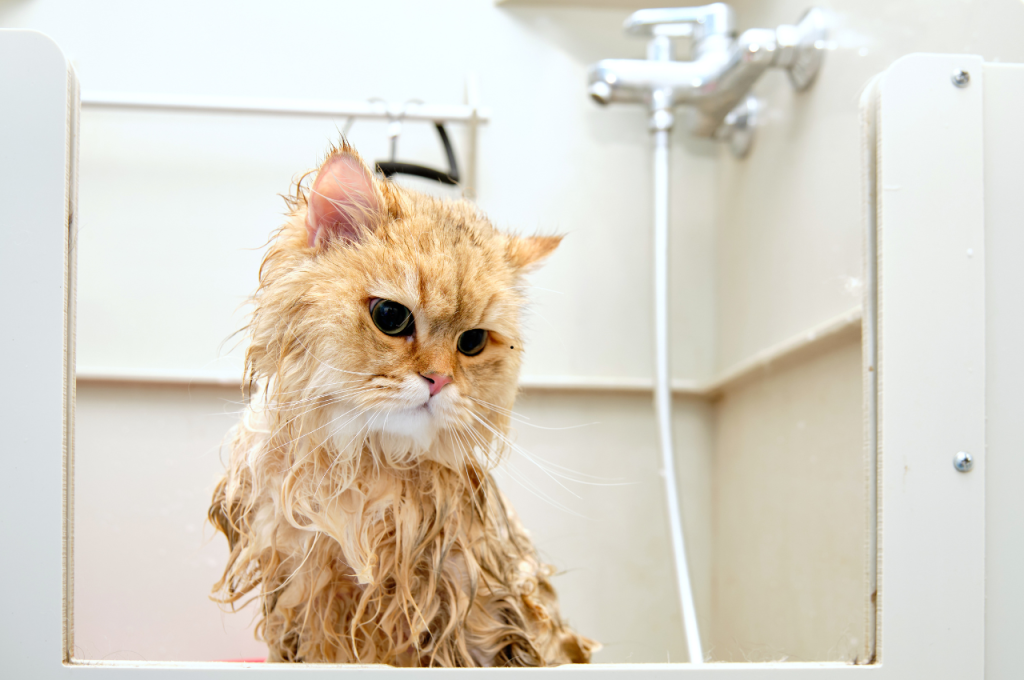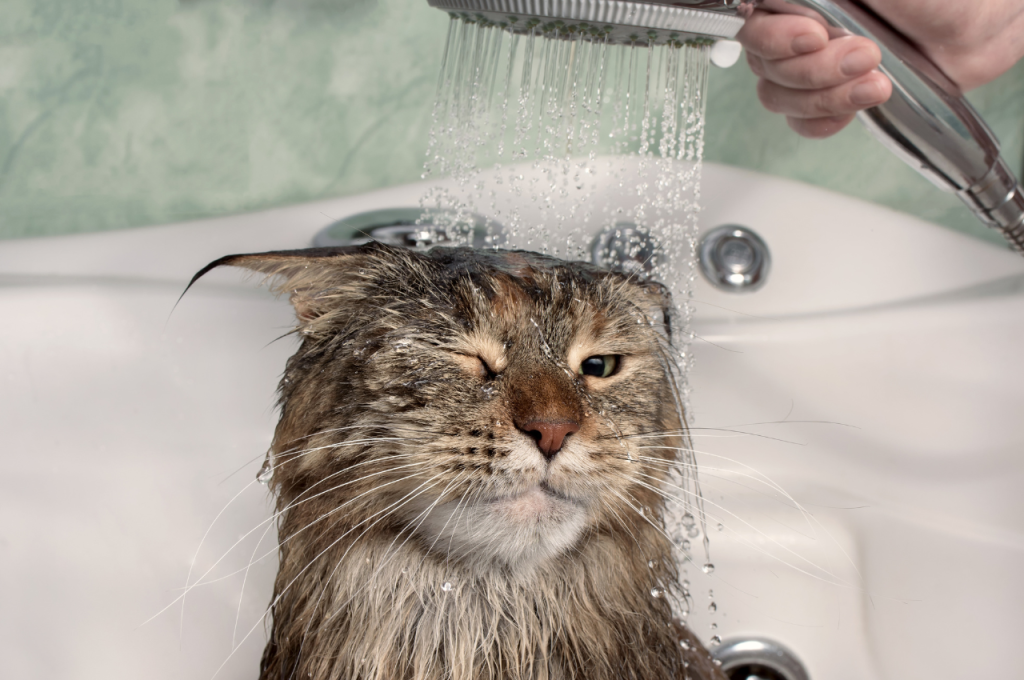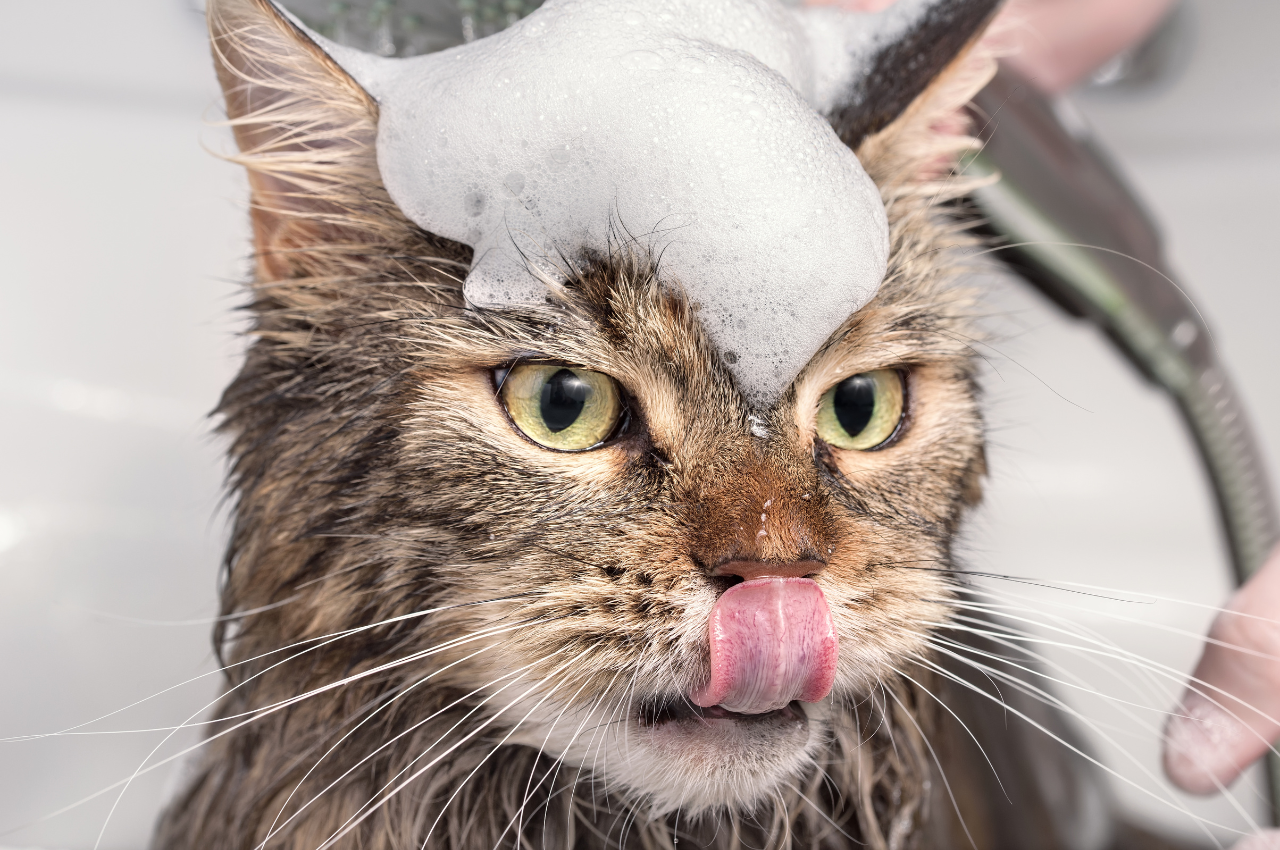To give a cat a bath, use a cat-specific shampoo and warm water, and try to keep the cat calm and relaxed throughout the process. Giving a cat a bath can be a challenging experience for both the cat and the owner.
While cats are generally clean animals that groom themselves, there are times when a bath is necessary, such as when the cat has gotten into something dirty or smelly. However, cats are not fond of water and may become agitated or anxious during the bath. Therefore, it is important to approach the process with care and patience and to take steps to keep the cat calm and relaxed throughout the bath. We will discuss some tips and techniques for giving your cat a bath, as well as some of the potential challenges you may encounter along the way.
Understanding Your Cat’s Tolerance
Understanding your cat’s tolerance is crucial when it comes to giving them a bath. Take note of your cat’s body language and reactions to water, as some cats may not tolerate being submerged at all. Gradually introduce your cat to water and use a cat-specific shampoo to minimize any potential discomfort.

Recognizing signs of stress in your cat is crucial before attempting a bath. Watch for flattened ears, hissing, or attempts to flee.
Recognizing Signs of Stress
- Flattened ears
- Hissing
- Attempts to flee
Building water familiarity gradually is key to a successful cat bath. Start by introducing your cat to water in a positive way.
Building Water Familiarity Gradually
- Use a shallow basin
- Offer treats and praise
- Gradually increase water depth
Gathering Supplies
Before giving your cat a bath, gathering the necessary supplies is essential to ensure a smooth and stress-free experience for both you and your feline friend.
Choosing The Right Shampoo
When selecting a shampoo for your cat, opt for a gentle, pet-specific formula that is free of harsh chemicals and fragrances. Look for mild, hypoallergenic options to minimize skin irritation.
Tools for a Smooth Bathing Experience
- Gentle pet shampoo
- Non-slip mat for the bathtub
- Soft towels
- Wide-toothed comb
- Small cup or pitcher for rinsing
Creating a Calming Environment
Create a calming environment before giving your cat a bath by preparing warm water, using a gentle pet shampoo, and speaking softly to soothe them. Slowly introduce your cat to water, starting with their paws, and gently massage the shampoo into their coat.
When it comes to giving your cat a bath, creating a calming environment is essential. Cats are known for their aversion to water, so it’s important to create a soothing atmosphere that will help them feel more relaxed and comfortable during the bathing process. In this section, we will explore some key strategies for setting the right water temperature and minimizing noise and distractions, ensuring a stress-free bathing experience for both you and your feline friend.
Setting the Right Water Temperature
To ensure your cat’s comfort, it’s crucial to set the water temperature at an optimal level. The ideal temperature for a cat’s bath is lukewarm, around 100°F (38°C). This temperature is similar to their body temperature, making it more comfortable for them to be immersed in. Avoid using hot water, as it can scald their sensitive skin, or cold water, which can cause discomfort and stress. By finding the right balance, you can create a soothing sensation that will help your cat feel at ease during the bath.
Minimizing Noise and Distractions
Cats are highly sensitive to their surroundings, so it’s important to minimize noise and distractions during their bath. Choose a quiet and secluded area for the bathing process, away from any loud noises or sudden movements that could startle your cat. Close windows and doors to reduce external noise, and turn off any electronics that could create unnecessary distractions. By creating a calm and peaceful environment, you can help your cat relax and make the bathing experience more enjoyable for both of you. In addition to minimizing noise, consider using soft, soothing music or white noise to drown out any unwanted sounds. The gentle melodies or calming sounds can help create a sense of tranquility and promote relaxation for your cat. Just be sure to keep the volume low to avoid overwhelming their sensitive ears.
Another effective way to create a calming environment is by using natural scents. Cats have a strong sense of smell, and certain scents can help reduce anxiety and promote relaxation. Lavender, chamomile, and valerian are known for their calming properties and can be used in the form of essential oils or sprays. Be sure to use cat-safe products and introduce the scents gradually to avoid overwhelming your cat’s senses.
By setting the right water temperature, minimizing noise and distractions, and incorporating calming scents, you can create a soothing environment that will help your cat feel more at ease during bath time. Remember, a calm and relaxed cat is more likely to have a positive bathing experience, making it easier for you to keep them clean and healthy.
The Bathing Process Step By Step
Gently introducing your cat to the bathing process can make it a stress-free experience. Start by gathering the necessary supplies, such as cat-friendly shampoo and a towel, and gradually acclimate your cat to the water before beginning the bath. Use a calm and reassuring tone throughout the process to keep your feline friend at ease.

Getting Your Cat Wet
Before starting the bathing process, it is important to get your cat wet. Begin by filling the sink or bathtub with warm water, ensuring the water level is shallow enough to prevent your cat from feeling overwhelmed. Gently place your cat in the water, allowing them to adjust to the sensation. Using a handheld showerhead or a jug, wet your cat’s fur thoroughly, making sure to avoid getting water in their ears and eyes.
Applying Shampoo
Once your cat is wet, it’s time to apply shampoo. Choose a cat-specific shampoo that is gentle and safe for their skin. Apply a small amount of shampoo onto your hands and gently massage it into your cat’s fur, starting from the neck and working your way down to the tail. Be careful not to apply excessive pressure or scrub too vigorously, as this may cause discomfort or skin irritation for your feline friend.
Rinsing Thoroughly
After applying the shampoo, it’s crucial to rinse your cat thoroughly to remove any residue. Use the handheld showerhead or jug to rinse your cat’s fur with warm water, ensuring all the shampoo is washed away. Take extra care to rinse the belly, legs, and tail, as these areas are prone to soap buildup. Make sure there are no remaining traces of shampoo on your cat’s fur, as it can cause skin irritation if left behind.
Remember, giving your cat a bath can be a challenging task, so it’s important to approach it with patience and a calm demeanor. Always reward your cat with treats and praise throughout the process to create a positive association with bathing.
Drying Your Cat Post-bath
After giving your cat a bath, proper drying is essential to prevent discomfort and potential health issues. Here’s how to ensure your feline friend is dry and comfortable post-bath:
Towel Drying Techniques
- Gently wrap your cat in a soft towel to absorb excess water without causing distress.
- Pat the fur delicately to avoid tugging or pulling on the skin.
- Change to a dry towel if the first one becomes saturated.
When to Use a Hair Dryer
Use a hair dryer on the lowest setting if your cat is comfortable with the noise and airflow. Maintain a safe distance to prevent overheating or startling your cat. Avoid pointing the dryer directly at the cat’s face to prevent discomfort.
Aftercare and Comfort
Ensure the aftercare and comfort of your cat during bath time by following these simple steps. Gently introduce them to water, use a cat-friendly shampoo, and provide a warm and calm environment. Remember to reward your furry friend with treats and praise for a positive bathing experience.
Aftercare and comfort are important aspects when it comes to giving your cat a bath. Once the bath is over, you need to ensure that your furry friend is comfortable and warm. This will help them to relax and get back to their normal routine quickly. In this section, we will discuss two important points to keep in mind when it comes to aftercare and comfort: providing warmth and comfort and rewarding your cat.
Providing Warmth and Comfort
After the bath, it is essential to dry your cat thoroughly. Use a soft towel to pat your cat down gently. Avoid rubbing too hard as this could cause discomfort. Once your cat is dry, it’s important to provide warmth and comfort. You can do this by wrapping your cat in a warm blanket or towel. This will help to keep them warm and cozy. You can also place a hot water bottle under the blanket or towel to provide extra warmth. Make sure the water bottle is not too hot and is placed in a way that your cat can move away if it gets too warm.
Rewarding Your Cat
Giving your cat a bath can be a stressful experience for them. Therefore, it’s important to reward them for their good behavior. This will help to reinforce positive behavior and make them feel loved and appreciated. You can reward your cat with treats or their favorite toy. Spend some time playing with your cat after the bath to help them relax and forget about the stressful experience. This will also help to strengthen the bond between you and your cat.
In conclusion, aftercare and comfort are essential when it comes to giving your cat a bath. Provide warmth and comfort by drying your cat thoroughly and wrapping them in a warm blanket or towel. You can also reward your cat for their good behavior to help them relax and feel loved. By following these tips, you can make the bath experience less stressful for your cat and strengthen your bond with them.
Troubleshooting Common Challenges
When it comes to giving your cat a bath, there are some common challenges you might encounter. Understanding how to troubleshoot these issues can help make the process smoother for both you and your feline friend.
Dealing with Aggressive Behavior
If your cat exhibits aggressive behavior during bath time, it’s essential to approach the situation with caution. Avoid sudden movements that could startle your cat further. Instead, speak to your pet in a calm, soothing voice to help de-escalate the tension. Before attempting to bathe an aggressive cat, it may be helpful to consult with a professional groomer or veterinarian. They can provide guidance on handling the situation and recommend techniques to minimize stress for your cat.
What to Do If Your Cat Hates Water
It’s not uncommon for cats to have an aversion to water, making bath time a challenging experience. If your cat resists getting wet, consider using a gentle, gradual approach to acclimate them to water. Start by introducing small amounts of water during grooming sessions to help your cat become more comfortable with the sensation.
Additionally, investing in feline-friendly grooming products can make the bathing process more tolerable for your cat. Look for shampoos specifically formulated for cats, as these products are designed to be gentle on their skin and coat.
Maintaining a Bathing Routine
Maintaining a bathing routine for your cat is essential to their overall health and hygiene. When giving a cat a bath, be sure to use a gentle cat-specific shampoo, and carefully introduce them to water gradually to minimize stress. It’s important to remain calm and patient throughout the process to ensure a positive bathing experience for your feline friend.

Determining How Often to Bathe Your Cat
Determining how often to bathe your cat depends on their coat type, activity level, and health. Generally, cats need a bath every few months, but long-haired or outdoor cats may require more frequent baths to stay clean and healthy.
Incorporating Bathing Into Your Cat’s Grooming Routine
To learn how to give a cat a bath, start by incorporating bathing into your cat’s grooming routine gradually. Use cat-friendly products, ensure a calm environment, and reward your cat with treats to create a positive experience, making future baths easier.
Conclusion
In caring for your feline friend, bathing can be a challenging but necessary task. By following these steps and tips, you can make the experience more pleasant for both you and your cat. Remember, patience, gentleness, and positive reinforcement are key to successfully giving your cat a bath.
